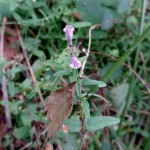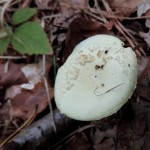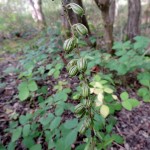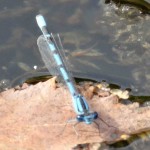Julia Cooper and Ian Duddle, helped by John Lerpiniere, led a walk at Paices Wood, Aldermaston on Wednesday 17th September. The walk started out across the grassy car park area and down to the lowest of the chain of 7 lakes which cross the site. A large patch of Great Horsetail was growing beside the path which led into the woods. The woods have a rich ground flora and plants seen included Male Fern, Yellow Pimpernel in flower and the leaves of Wood Sorrel, Bugle and Violets. The track led up to an open area, bounded by a neat woven fence, which enclosed a recently-coppiced section. The coppice stumps were growing back strongly, in contrast to the deer-damaged plants outside the fence. John pointed out where coppicing had taken place in earlier years. Continuing up the hill, an open section on the left of the path, with abundant flowering Common Fleabane, was described by John as a good place for butterflies and Drab Looper moths. A Bullfinch was heard calling nearby. To the right of the track was a bank with old multi-stemmed Field Maples, which marked the old trackway between Aldermaston and Brimpton Common. At the next junction was the fallen trunk of a big Oak. Beneath a large bracket fungus at its base, presumably Ganoderma applanatum, were the galls of the rare Yellow Flat-footed Fly Agathomyia wankowiczii, identified on a previous visit by Martin Woolner. According to the Buglife website, this is the only invertebrate in Britain which is known to cause a gall on a fungus. A grassy track bordered by willows led out onto an area of heather-covered heathland where a young Grass Snake was seen. Later in the walk, a dead Slow-worm was found on one of the tracks.
The route continued along a track into the woods of the Wasing Estate and past a small lake. The sun broke through the clouds and the first Speckled Wood butterflies took to the wing. A veteran Beech tree had Holly and Rowan seedlings growing from a fork in the trunk. A large area of open heathland opened up at the side of the path. A number of different species of fungi were seen, including Fly Agaric, False Death Cap, Common Earthball, Russula ochroleuca and Brown Birch Bolete. The next ride had a clump of Lesser Skullcap, with small pink flowers, by the side of the path. The track led back to the dam end of the lake, where a damselfly with a thickened blue segment at the base of a dark abdomen, resting with the wings half open, was identified as an Emerald Damselfly. The walk continued back into Paices Wood, then down the chain of lakes from the top. A clump of Broad-leaved Helleborines, with plump seed heads, was seen beside the path. Red Admiral and Peacock butterflies, a Common Blue Damselfly, Common Darters and a Brown Hawker were amongst the final sightings of the walk. Some of the group then went to the garden of the Hinds Head at Aldermaston for lunch.
Pictures by Rob Stallard and Laurie Haseler






